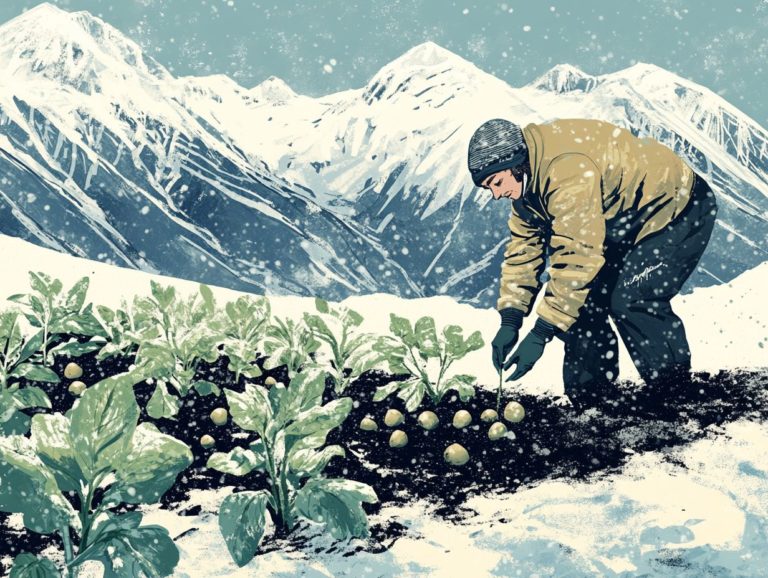What Indigenous Plants Thrive in Cold Regions?
Indigenous plants hold a crucial position in preserving ecological balance, especially in cold regions where the harsh climate presents distinct challenges.
This article examines the benefits of incorporating indigenous plants into your landscape. These plants enhance the environment and provide economic advantages. It explores the remarkable traits that allow these resilient species to thrive in colder temperatures. You will also find exemplary selections for your garden along with practical tips for their care and maintenance.
Discover how these plants can elevate your landscape while supporting local ecosystems.
Contents
- Key Takeaways:
- Benefits of Using Indigenous Plants
- Environmental and Economic Advantages
- Characteristics of Cold-Climate Plants
- Adaptations to Survive in Cold Regions
- Top Indigenous Plants for Cold Regions
- Caring for Indigenous Cold-Climate Plants
- Frequently Asked Questions
- What Indigenous Plants Thrive in Cold Regions?
- What are the Benefits of Growing Indigenous Plants in Cold Regions?
- How do Indigenous Plants Adapt to Cold Environments?
- Can Indigenous Plants be Used for Medicinal Purposes?
- Are Indigenous Plants Easy to Grow in Cold Regions?
- Where Can I Find Information on Indigenous Plants in Cold Regions?
Key Takeaways:

- Indigenous plants in cold regions have unique adaptations to survive harsh winters, making them low-maintenance and cost-effective options for landscaping.
- Using indigenous plants in cold regions provides numerous environmental and economic benefits, such as preserving biodiversity and reducing water and energy use.
- Some top indigenous plants for cold regions include conifers, deciduous trees, and perennials, which you can use for landscaping, food, and medicinal purposes.
Defining Indigenous Plants
Indigenous plants, or native species, flourish naturally in your area without human intervention. Understanding these plants is essential for successful gardening and landscaping, as they thrive in local climates and soil conditions.
These resilient plants support local wildlife and pollinators while enhancing the beauty and sustainability of your garden. They are perfect for both aesthetic appeal and ecological balance.
Indigenous plants have deep root systems that improve soil health and prevent erosion. This offers a clear advantage over many non-native species, which can become invasive. For gardeners in specific climate zones, opting for native varieties like Echinacea purpurea (Purple Coneflower) or Asclepias tuberosa (Butterfly Weed) guarantees vibrant blooms and a flourishing ecosystem.
These plants are particularly effective at attracting butterflies and hummingbirds, serving as essential nectar sources. By advocating for indigenous flora, you play a vital role in preserving biodiversity and cultivating a self-sustaining environment that thrives naturally.
Benefits of Using Indigenous Plants
Indigenous plants offer many benefits. They enrich biodiversity and promote sustainability. These native varieties are well-suited to local climates and soil conditions, making them more resilient and requiring less maintenance than non-native counterparts.
By embracing indigenous plants in your landscape, you nurture local wildlife and pollinators, while conserving native ecosystems. Your garden will thrive all year round with these plants, demanding less water and fertilizer a truly harmonious choice for nature and your personal oasis.
Join the movement! Start incorporating indigenous plants today for a vibrant and sustainable garden.
Environmental and Economic Advantages
The environmental advantages of utilizing indigenous plants go well beyond mere aesthetics; they also present significant economic benefits for you. Native plants are typically easier on the wallet when it comes to maintenance because they re perfectly adapted to local climates. This means they require less water, fertilizer, and pest control.
This not only slashes your garden maintenance costs but also supports pollinators and local wildlife, creating a vibrant ecosystem right in your yard.
By cultivating indigenous varieties, you can boost your property values and contribute to a more sustainable local economy, all while promoting native floral and horticultural businesses.
Incorporating these plants into your residential landscape can dramatically cut down on water usage and reliance on artificial fertilizers, making your gardening choices more eco-friendly.
Local ecosystems thrive as these plants attract native pollinators like bees, butterflies, and birds, which are essential for maintaining biodiversity.
Consider examples like xeriscaping, where drought-resistant plants such as lavender and sage not only help you save on irrigation costs but also elevate your yard s visual appeal. This makes your property more attractive to potential buyers.
This shift toward gardening with the environment in mind not only supports environmental sustainability but also encourages community engagement through local workshops and plant exchanges.
Characteristics of Cold-Climate Plants

Cold-climate plants are expertly adapted to endure the rigors of harsh winter conditions, showcasing distinctive traits that enable them to flourish in low temperatures. These resilient varieties typically boast deep root systems and specialized foliage.
Many plants enter a resting state (a period when plants stop growing to conserve energy) during the frigid months. Grasping these adaptations is essential for you as a gardener aiming to cultivate plants that can withstand cold weather, ensuring vibrant blooms and robust growth come spring.
Their resilience not only enhances the beauty of your landscape but also provides vital support for local wildlife and pollinators throughout seasonal transitions.
Adaptations to Survive in Cold Regions
Plants that thrive in cold regions showcase remarkable adaptations that enable them to endure winter’s chill and harsh climates. These cold-hardy species often develop thicker bark, smaller leaves, and deep root systems that tap into moisture locked beneath frozen ground.
Many plants enter a resting state, conserving energy and resources until warmer temperatures grace the landscape, ensuring their survival through extreme cold.
By understanding these adaptations, you can select the right species to create resilient and beautiful landscapes that flourish even in challenging conditions.
Take, for example, the Arctic Willow and the Siberian Blueberry, which have evolved to maximize their survival chances. The Arctic Willow’s low-growing form helps it stand strong against harsh winds, while its extensive root system efficiently retrieves precious water.
Similarly, many conifers, such as Spruce and Fir, have developed needle-like leaves with a waxy coating that minimizes water loss, making them ideally suited for snowy environments.
These traits not only bolster the plants’ resilience but also play a crucial role in fostering sustainable ecosystems. You have the power to create stunning gardens that thrive despite the challenges posed by frigid climates.
Top Indigenous Plants for Cold Regions
When choosing plants for cold regions, several standout indigenous varieties showcase resilience and beauty, making them perfect for your landscaping and gardening endeavors. Consider species like Rhododendrons, Daffodils, and Irises; they re not just visually striking but also finely tuned to thrive in USDA zones that face harsh winters.
These plants offer not only colorful blooms in spring and summer but also foster local pollinators, enriching the ecological value of your garden. By selecting the right varieties, you can create a vibrant landscape that highlights the splendor of nature while championing sustainability.
Examples and Uses
Indigenous plants present an exceptional array of options to enhance your garden or landscape, seamlessly blending beauty with ecological balance. Consider popular choices like Blueberries and Sedum. They can serve as vibrant flower beds or become wildlife-friendly shrubs that attract butterflies and other pollinators.
Trees such as Lilacs and Hydrangea add shade and structural interest to your garden design.
By incorporating these diverse plants, you elevate the aesthetic appeal and promote biodiversity while supporting local ecosystems.
A thoughtfully curated garden featuring native flora not only thrives but also becomes a sustainable habitat. For instance, when you plant Coneflowers alongside Liatris in a sun-drenched flower bed, you create a breathtaking display of colors while offering nectar for bees and butterflies.
Grouping plants with similar water and sunlight needs like pairing Yarrow with Black-eyed Susans facilitates easier maintenance and fosters healthier growth. This smart arrangement boosts their beauty and shows how indigenous plants can create a vibrant landscape, illustrating the significance of caring for the environment. The right combination of indigenous plants can yield a flourishing, low-maintenance landscape that benefits both you and the environment.
Caring for Indigenous Cold-Climate Plants

Caring for indigenous cold-climate plants demands a specific set of knowledge and techniques to ensure their thriving growth and maintenance throughout the shifting seasons. These resilient plants flourish in well-drained soil, receive adequate moisture, and soak up sunlight tailored to their specific needs.
Grasping the essential maintenance practices for these species like pruning and fertilization can greatly enhance their health and blooming ability. By employing effective care strategies, you can cultivate robust ecosystems that not only endure the cold but also attract local wildlife and pollinators, creating a vibrant, thriving environment.
Tips for Successful Growth and Maintenance
To achieve successful growth and maintenance of indigenous plants, follow essential tips designed for cold-hardy species. Ensuring proper soil composition, monitoring moisture levels regularly, and providing adequate sunlight are critical factors in cultivating these resilient plants.
Implementing winter protection techniques, such as mulching and strategic placement, can significantly enhance their survival during frigid temperatures. By following these guidelines, you can create a thriving landscape filled with vibrant blooms, lush shrubs, and a healthy ecosystem.
Understanding the unique needs of local flora is equally important. This includes recognizing how varying soil pH levels which measure how acidic or alkaline the soil is affect nutrient availability. Incorporating organic matter like compost not only enriches the soil but also improves drainage and aeration, which are crucial for root health.
Stay vigilant about moisture levels, especially during dry spells, as indigenous plants can be particularly susceptible to drought. Regularly inspecting your plants for signs of stress allows you to address issues before they escalate. Seasonal tasks, such as pruning in early spring and monitoring for pests, also play key roles in sustaining the vitality of your plants throughout the year.
Frequently Asked Questions
Here are some common questions about indigenous plants in cold regions.
What Indigenous Plants Thrive in Cold Regions?
Several indigenous plants thrive in cold regions, including arctic willow, Labrador tea, and the best native plants for cold climates, such as tundra rose.
What are the Benefits of Growing Indigenous Plants in Cold Regions?

Growing indigenous plants in cold regions can help support local ecosystems, provide food and shelter for native wildlife, and preserve traditional cultural practices.
How do Indigenous Plants Adapt to Cold Environments?
Indigenous plants survive in cold environments through several clever strategies. They develop deep roots and create natural substances that prevent freezing, along with specialized leaf structures that endure harsh weather.
Can Indigenous Plants be Used for Medicinal Purposes?
Absolutely! Many indigenous plants in cold areas have traditional uses. For instance, Labrador tea serves as a natural remedy for colds, while arctic cotton helps with respiratory issues.
Are Indigenous Plants Easy to Grow in Cold Regions?
Many indigenous plants are hardy and straightforward to cultivate in cold areas. They make excellent choices for home gardens and landscaping projects.
Where Can I Find Information on Indigenous Plants in Cold Regions?
Look for information on indigenous plants at local botanical gardens or conservation organizations. Government agencies that focus on preserving native plant species can also be valuable resources.






